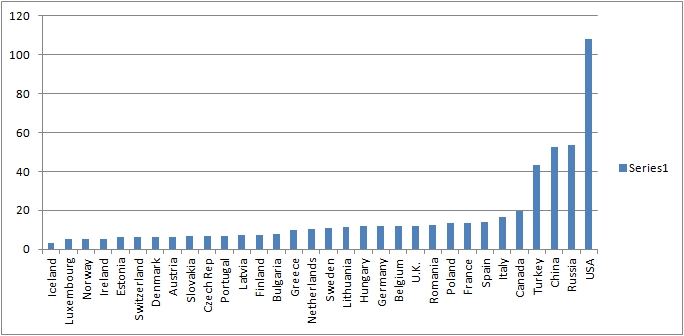Here is a little analytical challenge for a Monday morning. I produced it as a self-challenge to my preconceptions about the quality of life in other (mostly European) countries. The graph below shows the murder rate per million of population of selected countries. The data all derives from the same year, 2016 and is drawn via Wikipedia from apparently reputable sources. My source can be found here: https://en.wikipedia.org/wiki/List_of_countries_by_intentional_homicide_rate

The challenge I presented myself was simply to test the preconception that there are some countries that are much more socially stable than others. To my mind, that is a key determinant of a ‘successful’ country, one that might be held up as an example to others. Murder rates might be considered a suitable indicator of such. My experience, for example, of Germany and Switzerland is that they are so law-abiding and generally well-run that nothing truly, intentionally bad ever happens there. It is an illusion of course, and I know that.
But stereotypes are powerful. How easy is it to imagine a Swiss or German company being guilty of malpractice? The Volkswagen emissions scandal shows it can and does happen. Temptation is the same everywhere I guess, though the extent to which people act on it may not be. And temperament varies too.
Did I succeed? Well, only in part. There are considerable differences between murder rates (and that is without considering the absolute figures, which seem only partially reflect total population size).
I suggest that homicide rates are a reasonable indicator of social stability. The rise in knife-crime in the U.K. cannot be without its causes. So make of this self-created graph what you will. I know there are distortions introduced into the rankings, for example by the fact that I have not included all countries. In general, I have left out the smaller states except where they perhaps provided insight. In general, smaller nations seem to have lower homicide rates – from which we might learn something.
With my strong reservations about the way British society operates, I expected the U.K. to be towards the upper end of the European rankings – which it is. But so are France and Germany, the latter of which in particular I did not expect. On the other hand, Italy is not as much higher than the U.K. as might have been expected. I suppose we should also accept that the figures are only for reported murders; who knows what else goes on in some places…
Maybe we should simply conclude that there are certain factors at work in larger populations (increased anonymity perhaps) that affect perceptions of our fellows.
And it is also noticeable that some of the countries held up for their good social model seem to have higher than (I) expected murder rates, for example Finland and Sweden. I wonder if environmental factors are at work there – but then, Norway is lower. And even in the seemingly-model society of Switzerland (often held up as one of the world’s most civilised places to live), 45 murders happened in 2016. Personally, I have never met a Swiss who seemed capable of killing a fly… But it is necessary to remember that thanks to military service, the Swiss have loose gun-laws compared with the rest of Europe, and I suppose some people (including some Swiss I know, but not I) would instinctively blame their high immigrant populations. Who knows the truth?
Before jumping to too many conclusions, I suppose one should really conduct a much more detailed study of the circumstances and motives for murders, which might tell us much more than relatively raw totals.
The stark contrast with Russia and the USA are not a surprise – but might still teach us something about contrasting social models. The authorities in the U.S. had to deal with 17250 murders in 2016 alone. And spare a thought for Brazil, with its rate of 295 per million, or 61283 murders in that same year…